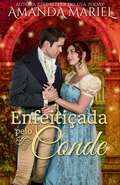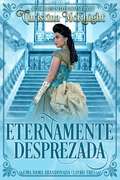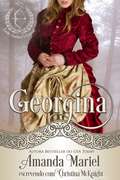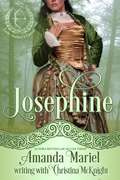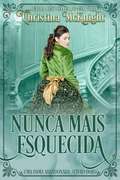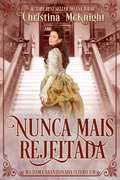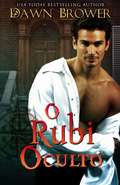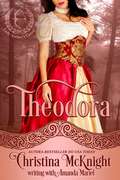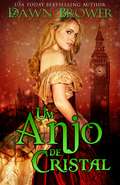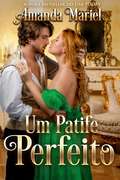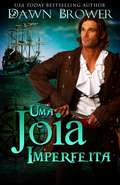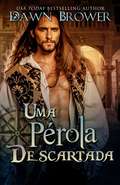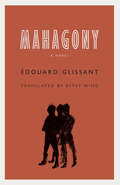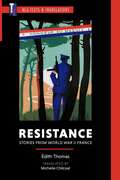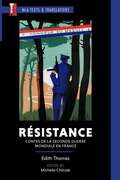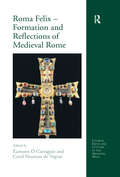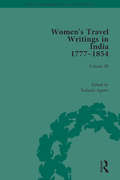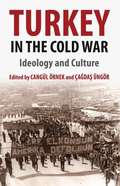- Table View
- List View
Enfeitiçada pelo Conde
by Éli Assunção Amanda MarielRose e Hunter vão superar suas diferenças e abrir os braços para o amor verdadeiro? Rose Woodcourt, uma costureira pobre, é orgulhosa demais para aceitar ajuda, mesmo quando seu lar e sua liberdade estão sendo ameaçados pelo infame Sr. Wolfe. Especialmente não de Hunter Thorne, um cavalheiro com título, que está muito acima da sua posição. Condes cortejam plebeias por uma razão e uma razão somente, e Rose não tem interesse em se tornar a amante de um homem rico – não importa o quão lindo e encantador ele seja. Hunter é um homem honrado: ele se recusa a dar as costas para aquela beleza vivaz, não importa o quanto ela o afaste. À medida que as ameaças do Sr. Wolfe evoluem para ações, Rose não tem outra opção a não ser recorrer a Hunter. Eles poderão colocar um fim às abomináveis façanhas de Wolfe antes que Rose perca tudo o que lhe é de mais querido, incluindo a sua liberdade?
Escandalosa
by Éli Assunção Amanda MarielUma encalhada por natureza, Jane há muito tempo aceitou que se tornaria uma solteirona. Talvez tal destino fosse o melhor. Depois de tudo o que testemunhou, viu em primeira mão o que um casamento miserável podia fazer com uma dama. Ainda assim se atreveu a sonhar – isso é, até se encontrar completamente escandalizada por um cavalheiro com os modos de um javali selvagem. Depois que Caleb Wesley, Lorde Keery, falhou em proteger a única pessoa que contava com ele, abraçou a vida de canalha. Mantinha os seus vícios perto – meretrizes, apostas e bebidas – e não tinha nenhuma intenção de desistir deles. Até que acidentalmente arruinou uma dama e foi forçado a pedi-la em casamento. Duas pessoas que foram atadas por circunstâncias indesejadas descobrem algo que nenhum acreditou que algum dia teria. Poderiam deixar as velhas feridas para trás e acreditar por tempo o suficiente para abraçar o presente que o destino tinha concedido a eles?
Escandalosa Redenção
by Éli Assunção Amanda MarielEla nunca o quis... Arruinada pelo escândalo, Claudia Akford sobreviveu aos anos do seu casamento com um animal cruel. Viúva, ela está determinada a recuperar o seu lugar entre a sociedade, mas Lorde Shillington é a tentação personificada. Bondoso e gentil, e ainda assim masculino e pecaminosamente bonito, ele seria o amante perfeito, mas ele quer mais do que ela está disposta a dar. Ele precisava dela... Enquanto Henry Shillington conhece um pouco sobre a linda e infame Lady Claudia Akford, ele é atingido por sua bondade, talento e comportamento espirituoso. Quanto mais tempo passa em sua companhia, mais sonho com um futuro ao lado dela. Mas a dama resiste às suas propostas honrosas, e uma amante nunca serviria para ele. Poderia duas pessoas cautelosas superar as dores do passado, um velho escândalo e as convenções sociais para viver o verdadeiro amor?
Escandalosas Intenções
by Éli Assunção Amanda MarielQuando confrontado com a possibilidade de perder o suporte do pai, o notório libertino Lorde Julian Luvington coloca seus olhos sobre Lady Sarah. Ela é tão respeitável quanto seus pares, exatamente o que o seu pai ordenou. Mas a dama não será fácil de conquistar. Lady Sarah Roseington está determinada a casar por amor ou permanecer solteira, e fará o que estiver ao seu alcance para obter a liberdade que é garantida aos homens. Um escroque como Lorde Luvington poderia destruir sua reputação conquistada a duras penas, mas casar com ele também oferece a ela as oportunidades que não pode alcançar por si só. O que uma dama faria? Quando Lorde Luvington se recusa a abandonar a sua caça, Lady Sarah propõe um acordo. Só que o preço pode ser bem mais alto do que qualquer um deles deseja pagar. Lady Sarah pode perder muito mais do que a posição social e Julian pode perder seu coração.
Esquemas Escandalosos
by Éli Assunção Amanda MarielLady Amelia está disposta a armar um escândalo para poder permanecer na sua amada Inglaterra. Lady Amelia apenas conheceu os confortos da vida em meados do século XVIII. Mas quando o seu pai morre, ela se encontra sozinha, miserável e menor de idade. Seu guardião designado, um tio americano, ordenou que ela se mudasse para a América onde ela deveria permanecer até alcançar a maioridade. Com a ajuda de Grace e Sarah, Amelia consegue que o seu tio concorde em dar a ela quatro semanas para resolver os seus negócios e sem que ele saiba... encontrar um lorde inglês para se casar. Apesar do seu período de luto, ela se empenha para envolver um dos solteiros mais elegíveis de Londres nas teias do matrimônio, assim ela pode permanecer na sua amada Inglaterra. O Duque de Goldstone é diabolicamente bonito, mas um Duque escocês é completamente inaceitável como um possível marido. Já que a Escócia não é a sua amada Inglaterra. E ainda por cima ele tem o horrível hábito de aparecer nas horas mais erradas e frustrar os seus planos que foram cuidadosamente planejados para laçar um marido adequado. Fagulhas voam quando o par se vê em desacordo um com o outro e ao mesmo tempo atraídos um pelo outro. Eles poderão encontrar uma forma de parar de discutir por tempo o bastante para explorar essa crescente paixão?
Eternamente Desprezada
by Éli Assunção Christina McKnightUm homem disposto a sacrificar tudo… Andrew Penton, o Marquês de Drake, é um homem acostumado a conseguir tudo o que quer, sem se importar com as consequências. Mas quando uma mulher misteriosa chama a sua atenção, não teve opção a não ser oferecer a ela tudo o que ele era. Uma mulher determinada a tomar tudo… Lady Lorelei de La Valette, filha do Comte de Epernon, é nova na sociedade de Londres e não era a dama que parecia ser. Sua vida tinha sido controlada desde o nascimento, mas ela ainda teria que decidir se o seu destino estava em seu país ou em seu coração. Um amor perdido para sempre…
Fascinada pelo Duque
by Éli Assunção Amanda MarielA senhorita Emma Baxter se escondeu em uma carruagem para fugir do tio e do barão com o qual estava sendo forçada a se casar. A última coisa que esperava era se encontrar com o Duque de Radcliffe, Aaron St. John, e sua filha de dez anos, Lady Sophia. Agora ela estava de frente a um perigo completamente diferente.
Georgina (Lady Archer's Creed Ser.)
by Éli Assunção Amanda MarielUma mulher determinada… Selvagem e irresponsável, Lady Georgina Seton tem planos para o seu futuro. Conduzida pela dor de um coração partido, fará o que quer que seja necessário para atingir seus objetivos… e ela está determinada a controlar o próprio destino. Ao se tornar a melhor arqueira que a Inglaterra já viu, conseguirá garantir seu futuro sem ter que se casar. Um homem ambicioso... Nascido sobressalente, Felton Crauford está inclinado a garantir o seu futuro acumulando riquezas. O veio mineral que descobre prometeu ser uma bênção, mas há um problema... a reserva segue para a propriedade vizinha. Para seu desespero, a moleca que mora ao lado faz qualquer coisa que pode para se meter em seu caminho. Tudo isso enquanto se prova uma tentação que ele não pode simplesmente ignorar. Felton e Georgina são apanhados em um anseio incontrolável que ameaça destruir os planos de ambos. Pior, eles são incapazes de controlar o desejo que arde entre eles. Georgina deve fazer suas apostas: Abrir seu coração uma vez mais ou se arriscar a perder tudo.
Josephine (Lady Archer's Creed Ser.)
by Éli Assunção Amanda MarielLady Josephine Watkins nunca planejou atirar no Duque de Constantan. Guiada pela culpa e determinada a vê-lo em plena saúde, ela se recusou a sair do lado dele. O que não imaginava era que o malicioso duque capturaria o seu coração. Devon Mowbray, Duque de Constantan, foi à Favershame Abbey por pura curiosidade. Ele só pretendia dar uma olhada no conde conhecido como a fera de Favershame, e ir embora. Nunca imaginou que uma bela e obstinada mulher fosse acertá-lo com uma flecha e roubar o seu coração. Apesar da mágica entre eles, um delicado segredo forçou Devon a afastar Josie. Mas sem ele saber, ela já tinha descoberto a verdade e ficou ainda mais determinada a conquistar o seu coração. Será que o amor será forte o bastante para resistir ao que ameaça mantê-los separados?
Nunca mais Esquecida
by Éli Assunção Christina McKnightUma dama esquecida por todos... Ruby St. Augustin precisava descobrir a verdade sobre o seu passado para então decidir o que faria com o seu futuro. Tinha pouco tempo para descobrir a identidade do seu verdadeiro pai e os segredos por trás do seu nascimento. Se alguém soubesse das suas intenções, ela seria a desgraça para todos aqueles a quem amava. Mas o que não esperava era chamar a atenção de um homem que não se importava nem com a própria reputação ou com o passado dela. Um homem fascinado por apenas uma mulher... Harold Jakeston é um homem sem riqueza ou título. Resignado a uma vida que odeia, ele tem a chance de ter algumas semanas de liberdade antes de ficar preso a um destino que não deseja. Quando ele fica preso na teia de mistério de uma mulher do seu passado, ele abraça a oportunidade de esquecer seu futuro premente. O que não tinha antecipado era que se apaixonaria por uma mulher que acenderia o seu desejo e que criaria um novo futuro para ele e para ela. Um amor que nenhum deles pode abandonar...
Nunca mais Rejeitada
by Christina Mcknight Éli AssunçãoUma dama desprezada por todos... um lorde traído por apenas uma pessoa... um amor impossível, destinado a acontecer Uma dama desprezada por todos… Lady Viola Oberbrook só queria esquecer aquela fatídica manhã quando um duelo tirou a vida de dois ricos e promissores jovens da ton e ela teve que fugir para a propriedade do pai no campo. Oito anos depois, ela tinha a vida em ordem: um negócio satisfatório, alguns amigos verdadeiros e nenhum plano de voltar para a sociedade de Londres. O que não esperava era ficar cara a cara com o seu passado... Um lorde traído por apenas uma pessoa… Brock Spencer, Conde de Haversham, só queria vingança. Tendo recentemente voltado do seu serviço militar, seus planos incluíam reparar a propriedade familiar, encontrar uma noiva e destruir a menina responsável pela morte dos seus irmãos. O que ele não esperava era se apaixonar pela única mulher que nunca deveria ser parte do seu futuro. Um amor impossível, destinado a acontecer…
O Rubi Oculto
by Dawn Brower Éli AssunçãoNoah St John, o Duque de Huntly, perdeu os pais ainda criança e cresceu tendo os advogados como guardiões. Quando conheceu Rubina Leone, foi amor à primeira vista. Pela primeira vez na vida acreditou que poderia ser feliz. Até que o destino mostrasse as garras e jogasse seu coração às feras – em um arroubo de raiva, Rubina o deixou. O navio em que ela viajava foi a pique. Depois de anos de luto, decidiu voltar a se casar. Mas dessa vez não comprometeria o seu coração. Não tinha um. Rubina Leone St John, a Duquesa de Huntly sempre pretendeu voltar para Noah. Mas antes que tivesse a chance de embarcar no navio um ex-noivo degenerado a raptou. Quando finalmente conseguiu escapar, tinha apenas um pensamento. Voltar para a Inglaterra para o único homem que já amou. Rubina volta correndo para casa para impedir o casamento do marido, mas será que ela conseguirá recuperar o coração de Noah ou é tarde demais para reavivar o amor que havia entre eles?
Para Sempre o meu Conde
by Dawn Brower Éli AssunçãoO amor verdadeiro só existe em contos de fadas. Ao menos é nisso que a senhorita Hannah Knight acredita. Os primeiros anos de sua vida foram cheios de dificuldades, mas carregaria uma lembrança para sempre consigo – mesmo nos tempos mais difíceis. O verão que passou no Castelo de Manchester, onde começou a sonhar com o felizes para sempre nos braços do homem que possui o seu coração. A guerra deixou Garrick Edward cínico. Ele nunca esperou herdar o título e se tornar o Conde de Manchester. Mas seu irmão bebeu até encontrar a morte precoce deixando uma filha para trás e uma montanha de dívidas. Relutantemente, ele retorna para o seu lar ancestral. Quando chega, encontra Hannah lá. Suas cartas durante a guerra tinham lhe dado esperança onde não havia nenhuma, entretanto, ele não acredita que mereça o seu amor. Enquanto reatam a sua amizade, encontram a esperança que ambos acharam ter perdido. No fundo dos seus corações, se agarram àquela esperança e começam a imaginar se alguns sonhos de fato não poderiam se tornar realidade. A pergunta é: Eles serão corajosos o suficiente para alcançá-los?
Theodora: Lady Archer's Creed (book One)
by Christina Mcknight Éli AssunçãoTer o seu futuro – e o de suas amigas – em perigo, fará com que Theodora concorde com um casamento desprovido de afeição, ou com que arrisque tudo pelo homem que possui o seu coração? Amizade... Lady Theodora Montgomery partiu da Escola de Educação e Decoro para Damas de Excepcional Qualidade da Senhorita Emmeline para comparecer à sua primeira Temporada em Londres – com suas três amigas mais queridas ao seu lado. Com sua inteligência afiada e habilidades no tiro com arco, Theo está muito mais interessada em ganhar um grande prêmio do que em garantir um marido. Mas quando é desmascarada em meio a um torneio, tendo o seu rosto exposto a todos, ela teme que a sua identidade, e os seus dias vagando por Londres, causem não apenas a sua ruína, mas a também a de suas amigas. Lealdade… O Sr. Alistair Price, herdeiro do idoso Visconde Melton, chegou à Londres com os seus oito irmãos mais novos a reboque. Ele está encarregado de manter o nome da família acima da censura até que a Temporada comece e a sua irmã, a Senhorita Adeline Price, for apresentada à sociedade – embora isso se prove muito mais difícil do que Alistair alguma vez esperou, principalmente quando ele descobre a sua rebelde irmã pulando o muro de casa e fugindo para Whitechapel direto para um torneio de tiro com arco. Seu foco se mantém em salvar a sua família da ruína e da desgraça que as ações de Adeline causaram – até que Alistair avista outra arqueira, sua flecha se conectando com muito mais do que o centro do alvo. E honra acima de tudo… Com o futuro de Theodora – e o de suas amigas – em perigo, ela concordará com um casamento desprovido de afeto ou arriscará tudo pelo homem que possui o seu coração?
Um Anjo de Cristal
by Dawn Brower Éli AssunçãoUma promessa de noivado enquanto estava bêbado fez toda a família de Thor ficar contra ele. Será que Thor ganhará o perdão de Pia e encontrará as suas crianças fujonas antes de Natal? Depois de uma noite de jogos e bebedeira, a terrível dor de cabeça que Thor está sentindo é o seu menor temor. Quando chega um mensageiro com um contrato para ele assinar, sua esposa Pia descobre que ele concordou comprometer o filho deles em noivado com a filha do Conde de Devon. Pia está extremamente furiosa e exige que ele dê um jeito na situação – se não... depois de ouvirem a briga dos pais, os gêmeos Liam e Lily decidem fugir em protesto ao contrato. Thor e Pia se reúnem para encontrar seus rebeldes filhos antes que algo horrível aconteça a eles. Thor conseguirá convencer Pia a perdoá-lo e eles encontrarão os gêmeos antes do Natal, ou a sua família irá se separar para sempre?
Um Beijo no Natal
by Christina Mcknight Éli AssunçãoUM DESEJO DE NATAL... Lady Pippa Godfrey teve a mais horrenda Temporada em Londres. Ela fugiu para sua propriedade em Somerset para passar um Natal tranquilo com a família, longe dos curiosos olhos da sociedade. Mas, antes de os pais poderem se juntar a ela, uma tempestade assola Somerset e destrói cada esperança que Pippa tinha de ver um Natal coberto pela neve. As estradas inundaram e viajar se tornou impossível, deixando-a sozinha e abandonada. Mas um cavalheiro coberto de lama, irado e diabolicamente bonito aparece em sua porta exigindo abrigo. Lucas Hartfeld, o Conde de of Maddox, tinha sido convocado pelos pais, o Marquês e a Marquesa de Bowmont, para ir a uma festa de natal nesse lugar esquecido por Deus, distante demais da sua casa em Londres. Ele suspeita que eles ordenaram a sua presença por razões muito diferentes do que uma simples festa no campo. Quando uma tempestade faz a sua carruagem encalhar, ele é forçado a procurar abrigo na única casa que viu em milhas, uma mansão local chamada Helton House. Quando Lady Pippa parece relutante em aceitá-lo, ele faz exatamente o que foi criado para fazer - exige que ela forneça abrigo para ele e para os seus criados até que a tempestade passe. Mas a bela mulher atraiu muito mais o seu interesse do que ele está disposto a admitir. Lucas poderá encontrar um meio de escapar do que os seus pais estão planejando? Enquanto Lady Pippa examina minuciosamente outro lorde arrogante e mandão, é bombardeada com as memórias das traições que sofreu em seu passado. Ela poderá esquecer aquelas difíceis lições de vida para reclamar um beijo de um completo estranho?
Um Patife Perfeito (O Beijo de um Patife #1)
by Éli Assunção Amanda MarielQuando Julia Honeyfield é enviada para um bordel, ela foge... Julia Honeyfield e a mãe estão em apuros depois que o pai de Julia as abandona. Sem dinheiro e doente, a mãe de Julia faz a única coisa em que pôde pensar para salvar a filha: envia Julia para um bordel em Londres. Quando Julia descobre a verdade, tenta escapar, mas acaba caindo nos braços de Charles, o Duque de Selkirk. Ela se atreveria a confiar nele para protegê-la... Charles não tem ideia do que fazer com a donzela em perigo, mas ele sabe que não pode virar as costas para ela. Algo em Julia captura o seu interesse, e sem pensar nas consequências, ele a leva para a sua propriedade. Assim que chegam lá, ele dá a ela um emprego como acompanhante da sua irmã, e recruta a mãe, a duquesa viúva de Selkirk, para ajudar a transformar Julia em uma dama. Uma noite muda tudo.. Quando Charles encontra Julia dançando sozinha no meio da noite, ele a toma nos braços. Esmagados pelo desejo, Julia e Charles se entregam à paixão. Agora tudo o que lhes é mais querido está em perigo – assim como os seus corações.
Uma Joia Imperfeita
by Dawn Brower Éli AssunçãoPieretta embarca em um navio sem saber que Thor está esperando para sequestrá-la e finalmente poder se vingar do seu avô. Será que o amor intervirá e alterará esse curso? Pieretta Carlyle tinha perdido o pai, e ficou sozinha no mundo, exceto por seu grand-père, o Comte Renard Dubois. O comte insiste que ela vá para a França viver com ele. Pieretta não quer deixar Charleston e o único lar que já tinha conhecido. Seu avô era o seu guardião, e ela deveria fazer o que ele mandava. Thor já tinha determinado o seu curso, e Pieretta era a chave para a sua vingança. Ele se tornou um pirata de forma involuntária depois que o sócio tentou assassiná-lo. Ele tinha que conseguir Pieretta de qualquer jeito, e não se importava em ter que saquear um navio para tê-la. Quando Pieretta e Thor se encontram, sentem uma atração instantânea, mesmo que este fato vá contra os seus melhores julgamentos. Pieretta está enojada com as ações do pirata. Thor sabe em que Pieretta acredita, mas segue em frente com o seu plano. Ela é apenas um meio para um fim. O que acontecerá dependerá da necessidade de Thor por vingança e da habilidade de Pieretta de perdoá-lo por seus atos covardes.
Uma Pérola Descartada
by Dawn Brower Éli AssunçãoPearla está fugindo do escândalo do seu casamento arruinado e encontra Damian em sua jornada. Pearla Montgomery está se curando de um coração partido. Ela estava prestes a se casar com o Duque de Huntly quando o casamento foi interrompido antes que eles terminassem de dizer “eu aceito”. A esposa supostamente morta do seu noivo tinha interrompido a cerimônia. Para se afastar do escândalo, ela foge de Londres. E então encontra um homem para o qual poderia entregar o coração, mas está com medo de deixar qualquer um se aproximar. Fugir começa a se tornar um hábito que ela não consegue largar. Damian, Conte Leone, se apaixonou por Pearla assim que a viu. Mesmo eles tendo se conhecido sob as piores circunstâncias. Infelizmente, ele era o irmão da mulher que tinha interrompido o casamento de Pearla. Um pequeno detalhe que o amor da sua vida parecia não conseguir esquecer. Ele não desistiria dela, mesmo se tiver que segui-la até o fim do mundo. Damian se comprometeu em fazê-la se apaixonar por ele, não importa o que estiver em seu caminho. Eles precisam transpor muitos obstáculos, mas o maior de todos serão os medos de Pia. Será que Damian conseguirá convencê-la a lhe entregar o seu coração e a confiar que ele o manterá seguro?
Mahagony: A Novel
by Édouard GlissantÉdouard Glissant&’s novels, closely tied to the theories he developed in Poétique de la Relation (Poetics of relation), are rich explorations of a deported and colonized people&’s loss of their own history and the ever-evolving social and political effects this sense of groundlessness has caused in Martinique. In Mahagony Glissant identifies both the malaise of and the potential within Martinican society through a powerful collective narrative of geographic identity explored through multiple narrators. These characters&’ lives are viewed back and forth over centuries of time and through tales of resistance, linked always by the now-ancient mahogany tree. Attempting to untangle the collective memory of Martinique, Mathieu, the contemporary narrator, creates a conscious history of these people in that place—a record that unearths the mechanics of misrepresentation to get at the fundamental, enduring truths of that history, perhaps as only the mahogany tree knows it.
Resistance: Stories from World War II France (Texts and Translations #34)
by Édith ThomasBased on real events of the French Resistance during World War II, Édith Thomas's stories explore how ordinary people respond to the extraordinary conditions of political occupation. The stories, first published under the title Contes d'Auxois (Auxois Stories) by an underground press in 1943, were written to oppose Vichy-Nazi propaganda and to offer encouragement to civilians who felt resigned to defeat.Whether lining up to wait for food, tuning in to a forbidden radio broadcast, adapting to living side by side with German soldiers, or preparing for an act of sabotage, the characters in these stories must make choices in highly compromised circumstances on a daily basis. As the characters confront their own suffering and that of others, their actions inspire readers to consider the nature of heroism, the idea that people can share a common humanity with their enemies, and the possibility for individuals to find solidarity in an overwhelming, isolating world.
Résistance: Contes de la Seconde Guerre mondiale en France (Texts and Translations #34)
by Édith ThomasBased on real events of the French Resistance during World War II, Édith Thomas's stories explore how ordinary people respond to the extraordinary conditions of political occupation. The stories, first published under the title Contes d'Auxois by an underground press in 1943, were written to oppose Vichy-Nazi propaganda and to offer encouragement to civilians who felt resigned to defeat.Whether lining up to wait for food, tuning in to a forbidden radio broadcast, adapting to living side by side with German soldiers, or preparing for an act of sabotage, the characters in these stories must make choices in highly compromised circumstances on a daily basis. As the characters confront their own suffering and that of others, their actions inspire readers to consider the nature of heroism, the idea that people can share a common humanity with their enemies, and the possibility for individuals to find solidarity in an overwhelming, isolating world.
Roma Felix – Formation and Reflections of Medieval Rome (Church, Faith and Culture in the Medieval West)
by Éamonn Ó Carragáin Carol Neuman de VegvarAfter the Roman empire fell, medieval Europe continued to be fascinated by Rome itself, the 'chief of cities'. Once the hub of empire, in the early medieval period Rome became an important centre for western Christianity, first of all as the place where Peter, Paul and many other important early Christian saints were martyred: their deaths for the Christian faith gave the city the appellation 'Roma Felix', 'Happy Rome'. But in Rome the history of the faith, embodied in the shrines of the martyrs, coexisted with the living centre of the western Latin church. Because Peter had been recognised by Christ as chief among the apostles and was understood to have been the first bishop of Rome, his successors were acknowledged as patriarchs of the West and Rome became the focal point around which the western Latin church came to be organised. This book explores ways in which Rome itself was preserved, envisioned, and transformed by its residents, and also by the many pilgrims who flocked to the shrines of the martyrs. It considers how northern European cultures (in particular, the Irish and English) imagined and imitated the city as they understood it. The fourteen articles presented here range from the fourth to the twelfth century and span the fields of history, art history, urban topography, liturgical studies and numismatics. They provide an introduction to current thinking about the ways in which medieval people responded to the material remains of Rome's classical and early Christian past, and to the associations of centrality, spirituality, and authority which the city of Rome embodied for the earlier Middle Ages. Acknowledgements for grants in aid of publication are due to the Publication Fund of the College of Arts, Humanities, Celtic Studies and Social Sciences at University College Cork; to the Publication Fund of the National University of Ireland, Dublin; and to the Office of the Provost, Ohio Wesleyan University.
Women's Travel Writings in India 1777–1854: Volume III: Mrs A. Deane, A Tour through the Upper Provinces of Hindustan (1823); and Julia Charlotte Maitland, Letters from Madras During the Years 1836-39, by a Lady (1843) (Chawton House Library: Women’s Travel Writings)
by Éadaoin AgnewThe ‘memsahibs’ of the British Raj in India are well-known figures today, frequently depicted in fiction, TV and film. In recent years, they have also become the focus of extensive scholarship. Less familiar to both academics and the general public, however, are the eighteenth- and early nineteenth-century precursors to the memsahibs of the Victorian and Edwardian era. Yet British women also visited and resided in India in this earlier period, witnessing first-hand the tumultuous, expansionist decades in which the East India Company established British control over the subcontinent. Some of these travellers produced highly regarded accounts of their experiences, thereby inaugurating a rich tradition of women’s travel writing about India. In the process, they not only reported events and developments in the subcontinent, they also contributed to them, helping to shape opinion and policy on issues such as colonial rule, religion, and social reform. This new set in the Chawton House Library Women’s Travel Writing series assembles seven of these accounts, six by British authors (Jemima Kindersley, Maria Graham, Eliza Fay, Ann Deane, Julia Maitland and Mary Sherwood) and one by an American (Harriet Newell). Their narratives – here reproduced for the first time in reset scholarly editions – were published between 1777 and 1854, and recount journeys undertaken in India, or periods of residence there, between the 1760s and the 1830s. Collectively they showcase the range of women’s interests and activities in India, and also the variety of narrative forms, voices and personae available to them as travel writers. Some stand squarely in the tradition of Enlightenment ethnography; others show the growing influence of Evangelical beliefs. But all disrupt any lingering stereotypes about women’s passivity, reticence and lack of public agency in this period, when colonial women were not yet as sequestered and debarred from cross-cultural contact as they would later be during the Raj. Their narratives are consequently a useful resource to students and researchers across multiple fields and disciplines, including women’s writing, travel writing, colonial and postcolonial studies, the history of women’s educational and missionary work, and Romantic-era and nineteenth-century literature. This volume includes two texts, Ann Deane, A Tour Through the Upper Provinces of Hindostan (1823) and Julia Maitland, Letters from Madras (1846).
Turkey in the Cold War: Ideology and Culture
by Cangül Örnek Çağdaş ÜngörThis volume examines the cultural and ideological dimensions of the Cold War in Turkey. Departing from the conventional focus on diplomacy and military, the collection focuses on Cold War's impact on Turkish society and intellectuals. It includes chapters on media and propaganda, literature, sports, as well as foreign aid and assistance.
